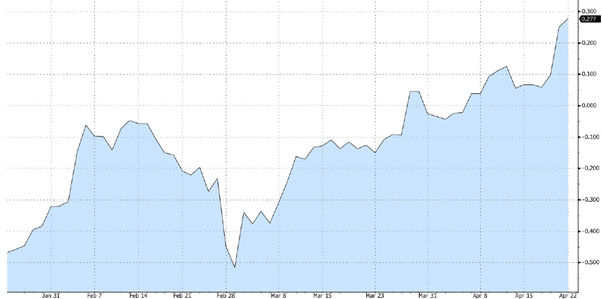
The Tale of the Yen
19 April 2022
How low can the euro go?
3 May 2022INSIGHT • 26 APR 2022
ECB’s Pivot in Stance and What it Could mean for the EUR

Ali Jaffari, Head of North American Capital Markets
Chart 1: Market Implied ECB Policy Rate (by End of 2022)

Source: Bloomberg
If the ECB kicks-off its hiking cycle as expected at the July meeting, there are some inherent risks to consider and their impact to currency markets.
1. Central banks unwound Euro holdings as rates went negative, a swift reversal could be underway
Resorting to negative interest rates was met with a steep sell off in the Euro and led to major central banks unwinding Euro reserves in 2014. The prospect of a positive rates story after almost a decade of negative yields will support the Euro and potentially add a floor to the already weakened currency.
2. Peripheral yield spreads could further widen
Lending rates have historically been low across the Euro zone and ultra-accommodative monetary policy has further narrowed the dispersion across EU nations. However, under a tightening cycle, higher leverage economies (i.e. Italy, Spain, Portugal etc) will be disproportionately impacted and greater credit risk / sovereign stress can cause peripheral yield spreads to widen.
This could lead to greater instability across the Euro zone and place downward pressure on the Euro. The ECB may need to revisit its tightening approach and further ease into it if debt serviceability concerns arise.
3. Rising rates coupled with unsustainably high energy prices could aggravate the economic climate
Energy prices are already at elevated levels and the entire region is feeling the pressure. With the French election now behind us and President Macron remaining in power, his support for EU sanctions on Russian oil could further exacerbate the energy crises and undoubtedly increase the likelihood of a recession.
Although the ECB will likely need to be accepting of stagflation risks in the near-term, a recessionary outlook may be one where it might have to dive back into its monetary toolkit.
The likelihood of a ban on Russian energy exports is wielding its way into market sentiment and inflation expectations. Market-based inflation expectations in the Euro zone have been trailing the US since 2009 (see Chart 2). However, in recent weeks the Euro has caught up and is expected to surpass that of the US given the lingering uncertainty around the oil sanctions and prospect of consumer prices peaking in the US.
Hence, despite heightened risk factors across the globe, near-term market risk remains increasingly concentrated on the trajectory in the Euro zone. The ECB’s delay in curbing inflation widens its monetary divergence with other central banks and continues to weigh on the Euro (hit a 2-year lower vs the dollar).
Chart 2: USD (blue) vs Euro (black) 10-Year Inflation Swaps

Source: Bloomberg
With significant uncertainty and rising stagflation risks on the horizon, the challenges for the Euro remain clear. The ECB will take a calculated approach to its tightening cycle as it balances higher rates with sluggish growth. As volatility persists, prudent risk management remains central to navigating market risk.
Be the first to know
Subscribe to our newsletter to receive exclusive Validus Insights and industry updates.


